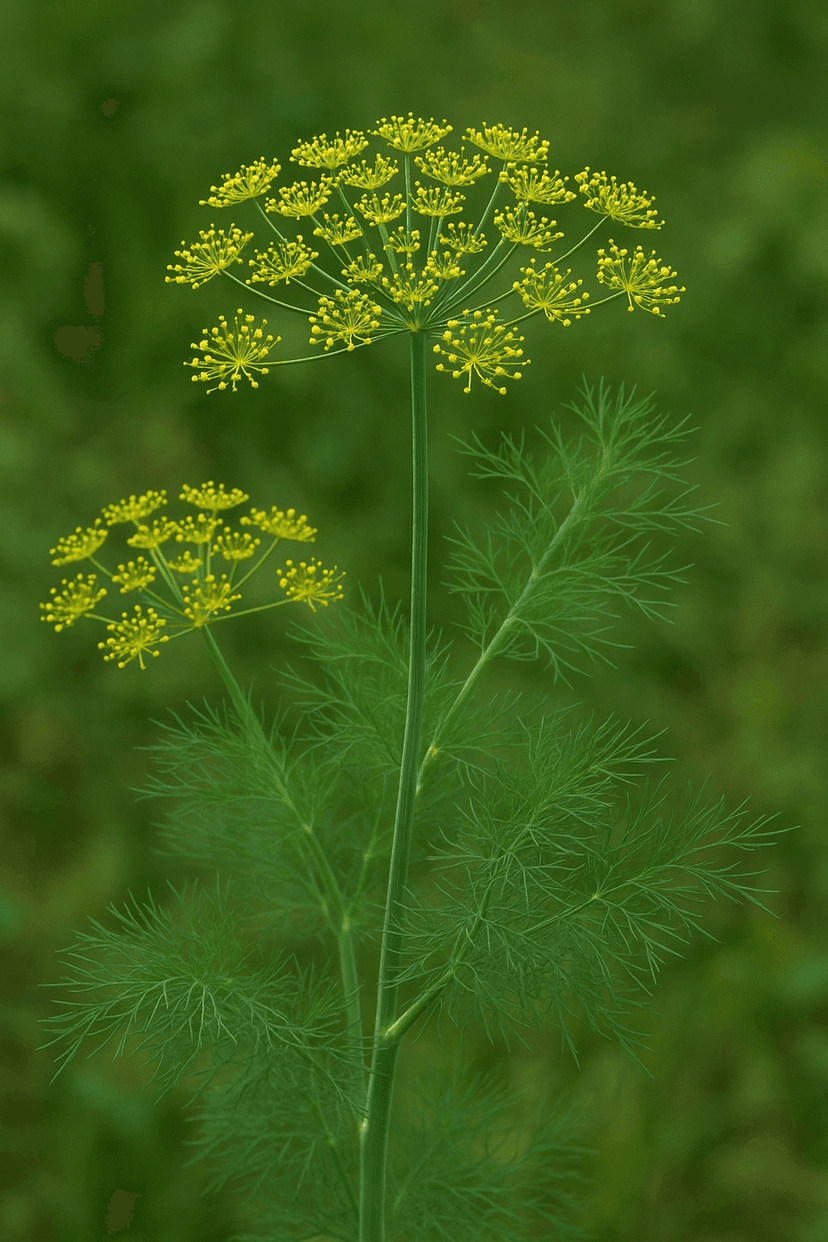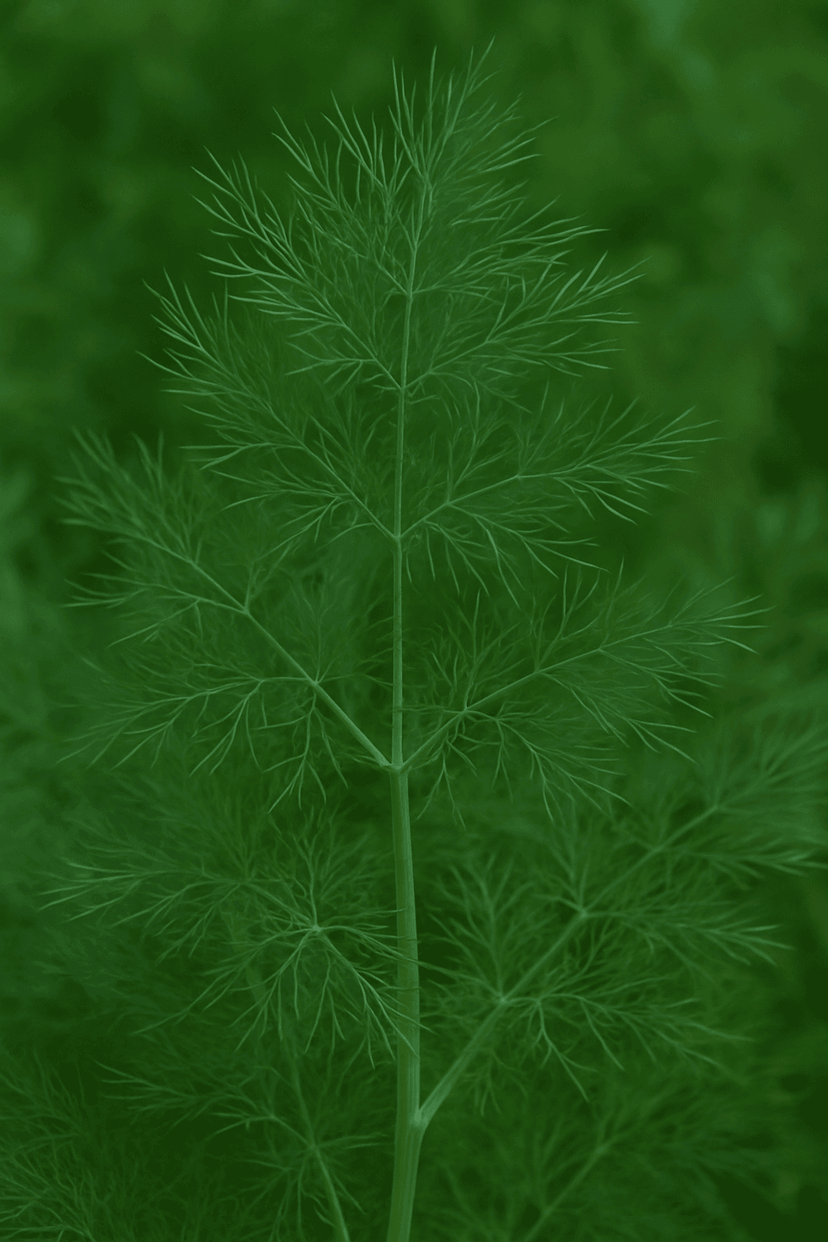

Common Name
Dill, dillweed, dill seed
Family
Apiaceae (Umbelliferae)
Parts Used
Leaves (“dillweed”), fruits (commonly called “seeds”), and essential oil
Native To
Mediterranean–West Asian origin; now widely cultivated across Europe, the Middle East, South Asia, and North Africa
Historical and Traditional Uses:
Culinary aromatic used fresh (leaves) and as a spice (fruits). Traditional carminative/antispasmodic for bloating, dyspepsia, infant “gripe water;” galactagogue uses are described in folk medicine. (Modern clinical evidence is limited; see below
Chemical Composition:
- Essential oil (fruit/leaf): rich in carvone and limonene; profiles may also include dill ether, α-phellandrene, dihydrocarvone, and dillapiole (percentages vary by plant part, cultivar, and origin).
- Non-volatile constituents: phenolics/flavonoids, coumarins, minerals, and small amounts of fixed oil. (Qualitative.)
Pharmacological Properties:
- GI smooth-muscle effects: antispasmodic/carminative activity observed in preclinical models basis for traditional dyspepsia/colic uses.
- Metabolic signals: hypolipidemic and antihyperglycemic effects reported in animal studies and small human trials (likely multi-mechanistic: bile acid modulation, antioxidant effects).
- Antimicrobial/antioxidant: essential oil driven effects in vitro (organisms and potencies vary with chemotype)
Evidence-Based Uses and Benefits:
1.Glycemic & Lipid Markers (adjunct use; early clinical evidence)
- Randomized, double-blind trial in type 2 diabetes (n=42): 3 g/day dill powder for 8 weeks improved fasting glucose and some lipid parameters vs. placebo; benefits modest and product-specific.
- RCT in metabolic-syndrome determinants (12 weeks): dill extract produced improvements in lipid profile in some endpoints; results heterogeneous.
- Systematic overviews stress the need for larger, well-controlled RCTs before firm conclusions. 2.Functional GI discomfort (traditional use; limited modern data)
- Historical use for bloating/flatulence is supported by preclinical antispasmodic data; contemporary human studies are sparse. Combination infant-colic products that include dill oil + fennel oil show signal in small trials but cannot isolate dill’s effect.
Not established: claims for lactation enhancement, broad antimicrobial therapy, or weight loss lack robust human evidence.
Counter Indications:
- Pregnancy: culinary amounts are acceptable, but avoid concentrated medicinal doses/essential oil due to traditional emmenagogue concerns and limited safety data.
Known Apiaceae spice allergy (celery–mugwort–spice syndrome): risk of cross-reactivity with dill
Side Effects:
Generally well tolerated in food amounts.
- Allergy/sensitization: rare oral-allergy or contact reactions; carvone/limonene oxidation products may sensitize skin—use fresh, well-stored oils and proper dilution.
GI upset possible with large doses of extracts/oils.
Drug Interactions:
- Antidiabetic drugs: potential additive glucose-lowering with dill supplements used for glycemic endpoints monitor glucose and adjust therapy as needed. BioMed Central
- Antihypertensives/lipid-lowering agents: human interaction data are lacking; consider monitoring if using standardized dill products targeting these markers.
- Allergy immunotherapy context: patients with pollen (e.g., mugwort/birch) related spice allergy may react to dill; coordinate with an allergist.
Research and White Papers with Links:
1.Dill powder 3 g/day improved glycemic and some lipid markers over 8 weeks: https://pmc.ncbi.nlm.nih.gov/articles/PMC7275438/
2.Cardiometabolic risk–factor review concludes more high-quality RCTs are needed. https://pubmed.ncbi.nlm.nih.gov/32188263/
3.Essential-oil composition reviews/chapters: https://pmc.ncbi.nlm.nih.gov/articles/PMC10974297/
4.Colic combinations in infants: https://pmc.ncbi.nlm.nih.gov/articles/PMC6659398/
Conclusions:
Dill is a culinary herb with a long GI carminative tradition. Its essential oil is carvone/limonene-rich, explaining aroma and much of the preclinical antispasmodic/antimicrobial activity. Early human trials suggest modest improvements in glycemic and lipid markers with standardized dill fruit powder/extracts, but larger, well-controlled studies are required before strong therapeutic claims. Culinary use is widely safe; avoid high-dose extracts/essential oil in pregnancy and in individuals with Apiaceae spice allergies. If used alongside glucose-lowering medications, monitor for additive effects.
